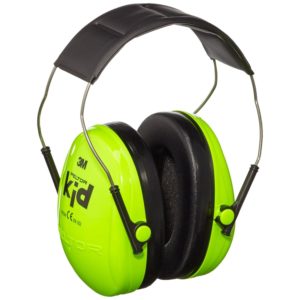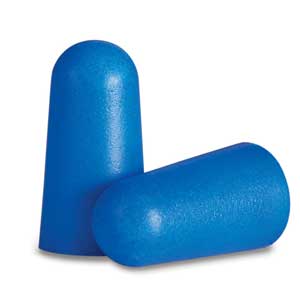If you have a job that requires hearing protection, then you’ll have to choose between earplugs or ear muffs at some point. They each have their own advantages and disadvantages. In order to choose the right one, you should consider what they offer. Our guide will look at the differences between plugs and muffs to help you make a smart choice.

Ear Muff Benefits
The main advantage of using ear muffs is that they fit snugly. They don’t have to be specially made or prepared, and can be placed over your head. That makes them the ideal choice for intermittent use and they are particularly suitable for landscaping and construction work.
As ear muffs are easy to fit, they offer a reliable, consistent fit. That means that the protection the person wearing them gets will match the protection the ear muff claims to offer. That is important because workers might not always be able to fit earplugs properly.
For a cooler climate, ear muffs are the more comfortable choice when wearing ear protection for a prolonged period of time. For warmer climates, earplugs might prove to be more comfortable due to the humid, warm nature of ear muffs.
Drawbacks of Ear Muffs
Ear muffs are easier to fit, but they generally offer less protection than earplugs. That is because ear muffs only sit over the ears, instead of fitting directly into the ear canal like plugs. That ear muffs cover the ears can become a problem with hot environments, as the heat builds up and can become discomforting for a user.
Another problem with ear muffs is that they lose some of their protection when worn with other PPE, such as with safety glasses.

Earplug Benefits
The main advantage of using ear plugs is that they provide much better protection. As they fit directly into the ear canal, they can provide far more protection than basic ear muffs. That means that they are best when you need a lot of protection, such as in a loud workplace like an airport, foundry, or factory.
Earplugs are also easy to carry and fairly light. Given how small they are, they can be kept in specially designed cases that fit into your pockets. Ear muffs, on the other hand, are more difficult to carry and keep safe. They can be cumbersome for some workers.
If you have to wear other kinds of PPE, then earplugs might be the right choice. As earplugs fit comfortably into your ear canal, they can be worn with other PPE. That makes them a good choice for people who also have to wear things like safety glasses and helmets.
Drawbacks of Earplugs
The main drawback of using earplugs is how difficult they can be to fit. They need to be fitted properly to the ear canal for maximum protection, and that can be difficult to guarantee. If an employee is trained on fitting earplugs properly though, then they can consistently provide the necessary protection.
Another problem with using earplugs is that they are difficult, if not impossible, for those with ear infections to wear. Earplugs are not a good fit in those cases as they would likely be too uncomfortable.
No matter what kind of hearing protection you go with, the main factor to consider is how much hearing protection they provide. Hearing protection comes with a “dB” rating which indicates how much noise they reduce. It’s important that you understand how much protection you need. After determining that, you can choose the right earplugs or ear muffs for you.
Types of Earplugs
There are several different types of earplugs available on the market, each with its own unique features and benefits. Let’s take a closer look at some of the most popular options:
Foam Earplugs: These are the most common and affordable type of earplugs. They are made of soft, compressible foam that expands to fit snugly in your ear canal. Foam earplugs are disposable and can be used for a variety of purposes, including sleeping, studying, or protecting your hearing from loud noises.
Silicone Earplugs: Unlike foam earplugs, silicone earplugs are reusable and can be washed and reused multiple times. They are made of a soft, flexible silicone material that molds to the shape of your ear canal. Silicone earplugs are often more comfortable than foam earplugs for extended wear and are a popular choice for people who need to wear earplugs frequently.
Wax Earplugs: These earplugs are made from a soft, moldable wax material that can be shaped to fit your ear canal. Wax earplugs are a popular choice for people who need to wear earplugs while swimming or bathing, as they provide a tight seal that prevents water from entering the ear canal.
Musician’s Earplugs: As the name suggests, these earplugs are designed specifically for musicians and concert-goers. They are made of a special material that filters out loud noises while still allowing you to hear music and other sounds clearly. Musician’s earplugs are a great choice for anyone who needs to protect their hearing while still being able to hear what’s going on around them.
This additional content should be inserted after the section on “Drawbacks of Earplugs” in the main article.
Choosing the Right Earplugs
With so many different types of earplugs available, it can be difficult to choose the right one for your needs. Here are some tips to help you make the best choice:
- Consider the noise level: If you need earplugs for a very loud environment, such as a construction site or a rock concert, you’ll want to choose earplugs with a high noise reduction rating (NRR). If you just need earplugs for sleeping or studying, a lower NRR may be sufficient.
- Think about comfort: If you’ll be wearing earplugs for extended periods of time, it’s important to choose a comfortable option that won’t cause irritation or discomfort. Silicone earplugs are often a good choice for extended wear, as they are soft and flexible.
- Consider reusability: If you’ll be using earplugs frequently, you may want to choose a reusable option, such as silicone earplugs, to save money in the long run.
- Look for a good fit: Earplugs that don’t fit properly won’t provide adequate noise protection. Look for earplugs that come in different sizes or that can be molded to fit your ear canal.
Remember, the most important factor when choosing earplugs is finding a pair that provides adequate noise protection while also being comfortable to wear. Don’t be afraid to try out different types of earplugs until you find the perfect fit for your needs.
Photo “Ear Muffs” by Anthony Cunningham for Zoom Health
Zoom Health is a leading UK supplier of Home Health Tests and Earplugs





